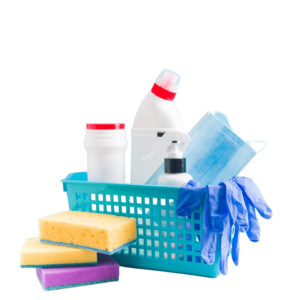When it comes to maintaining a clean and healthy home or office, regular cleaning is important, but there’s a deeper level of cleanliness that should not be overlooked: deep cleaning. While many people understand the importance of a tidy space, deep cleaning goes beyond the surface, tackling hidden dirt, bacteria, and allergens that accumulate over time. In this comprehensive guide, we’ll explore everything you need to know about deep cleaning and why it should be part of your regular maintenance routine.
What is Deep Cleaning?
Deep cleaning is a thorough and intensive cleaning process that targets areas often missed during routine cleaning. Unlike regular cleaning, which might only address visible surfaces, deep cleaning focuses on areas that accumulate dirt, dust, and germs in places you might not even think about, such as behind appliances, baseboards, and inside vents.
This type of cleaning is essential for improving air quality, preventing mold growth, and creating a healthier environment. It’s especially crucial for individuals with allergies, asthma, or respiratory conditions, as deep cleaning removes allergens like dust mites, pet dander, and mold spores.
Why Is Deep Cleaning Important?
Deep cleaning is much more than just giving your home a fresh, clean look—it offers a range of benefits that contribute to your overall well-being and the longevity of your belongings.
1. Improved Air Quality
Dust, pollen, pet dander, and mold spores can accumulate in hidden areas such as vents, carpets, and furniture. When left unchecked, these contaminants can significantly affect the air quality in your home. Deep cleaning removes these allergens, improving indoor air quality and making your space healthier to breathe in.
2. Health Benefits
Germs and bacteria can thrive in areas that are not regularly cleaned, such as bathroom corners, kitchen appliances, and under furniture. Deep cleaning eliminates harmful microorganisms, reducing the risk of illness. For households with young children or elderly individuals, this is especially important.
3. Prevention of Mold and Mildew
Mold thrives in damp and often unnoticed areas, such as under sinks, in bathrooms, and around window frames. Deep cleaning helps identify and address moisture issues that could lead to mold or mildew growth, preventing damage to your home and health problems.
4. Increased Longevity of Appliances and Fixtures
Over time, dirt and grime can build up on appliances, causing them to wear out more quickly. Deep cleaning not only keeps your appliances looking new but also helps maintain their functionality, which can save you money on repairs and replacements.
5. Enhances Home Aesthetics
Let’s face it—nothing feels more satisfying than a truly clean space. Deep cleaning removes stubborn stains, scuff marks, and other buildup that regular cleaning may miss. It’s a great way to refresh the look of your home and create a welcoming atmosphere for family, friends, or clients.
When Should You Deep Clean Your Home or Office?
While deep cleaning is essential, it doesn’t need to be done every day or even every week. However, scheduling deep cleaning sessions periodically ensures that your space remains healthy and well-maintained.
Suggested Deep Cleaning Schedule:
● Quarterly Deep Cleaning: For most homes, deep cleaning should be done every three to four months. This frequency works well for busy households that clean regularly but need to tackle neglected areas.
● Seasonal Cleaning: Many people choose to deep clean during the changing seasons—spring and fall cleaning, for example. This is a great way to ensure that your home is in top shape before and after the summer and winter months.
● Move-In/Move-Out Cleaning: If you’re moving into or out of a home or apartment, it’s important to deep clean the space before settling in or handing over the keys.
Deep Cleaning Checklist: What to Clean and How to Do It
A successful deep cleaning job requires a comprehensive approach. Use this checklist to make sure you hit every critical area during your cleaning session:
Living Areas & Bedrooms:
● Baseboards and Trim: Dust and wipe down baseboards and trim, which can accumulate dust and dirt.
● Ceiling Fans and Light Fixtures: Remove dust from ceiling fans, light fixtures, and chandeliers using a microfiber cloth or a specialized duster. ● Under Furniture: Move furniture to clean under couches, chairs, and tables. Use a vacuum or mop to get rid of dust, dirt, and pet hair.
● Carpets and Rugs: In addition to vacuuming, consider using a carpet cleaner to deep clean carpets and rugs. Alternatively, you can have them professionally cleaned.
● Windows and Curtains: Clean windows inside and out, and wash or dry clean curtains to remove dust and stains.
● Air Vents and Ducts: Use a vacuum attachment to clean air vents and ducts to ensure clean airflow.
Kitchen:
● Cabinets and Drawers: Empty cabinets and drawers to clean inside, removing crumbs, grease, and food residue.
● Appliances: Deep clean appliances, including the oven, refrigerator, microwave, and dishwasher. For example, clean the oven’s self-cleaning feature, scrub fridge shelves, and clean grease from the stovetop.
● Sink and Faucet: Disinfect and scrub your sink, faucet, and disposal area. Don’t forget to clean around the faucet handles where grime can build up. ● Countertops: Use an appropriate cleaner for your countertop material (granite, marble, laminate, etc.) to remove spills, stains, and buildup.
Bathrooms:
● Shower and Bathtub: Remove soap scum and mildew from shower walls, bathtub, and fixtures. Use a non-toxic cleaner to prevent damage to surfaces. ● Toilets and Sinks: Deep clean and disinfect toilets and sinks, paying special attention to hard-to-reach areas.
● Mirrors and Glass: Clean mirrors and any glass shower doors or windows to remove water spots and grime.
● Tile Grout: Use a grout cleaner to remove discoloration from tile grout, especially in shower or bathroom areas.
Additional Tasks:
● Walls and Doors: Spot clean walls and doors for fingerprints, stains, or dust. Use a gentle cleaner to avoid damaging paint or wallpaper.
● Closets: Organize your closet by donating items you no longer need. Wipe down closet shelves and vacuum the floor.
● Entryway: Deep clean the entryway, including the door, doormat, and any coat hooks or shoe racks.
DIY vs. Professional Deep Cleaning
While you can certainly tackle deep cleaning yourself, there are times when it’s better to hire a professional cleaning service. Here are some factors to consider:
● DIY Cleaning: Ideal for those on a budget or with the time and energy to handle cleaning themselves. However, deep cleaning can be time-consuming and physically demanding.
● Professional Cleaning: Hiring professionals can save time and ensure a more thorough job, particularly for larger spaces, difficult tasks (e.g., carpet cleaning), or specialized cleaning (e.g., air ducts).
Conclusion
Deep cleaning isn’t just about keeping your space looking pristine—it’s about maintaining a healthier, safer, and more enjoyable environment. Whether you decide to take on the task yourself or hire a professional, incorporating deep cleaning into your routine is one of the best investments you can make for your home or office.
By following this guide, you can ensure your space is spotless, free from allergens, and better equipped to stand up to the wear and tear of daily life. Happy cleaning!









